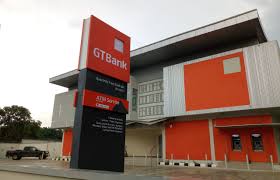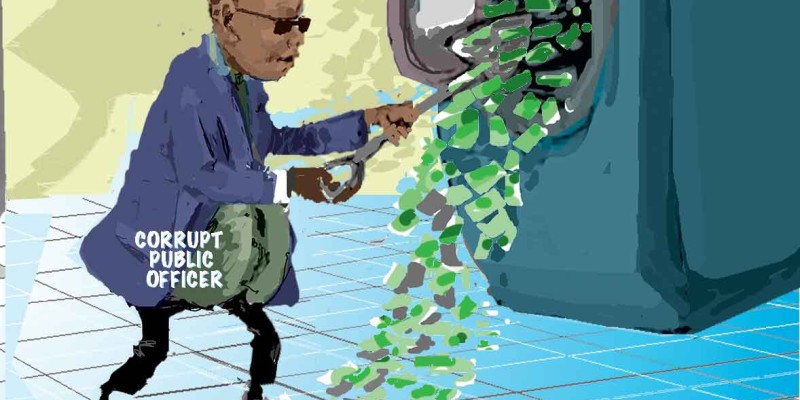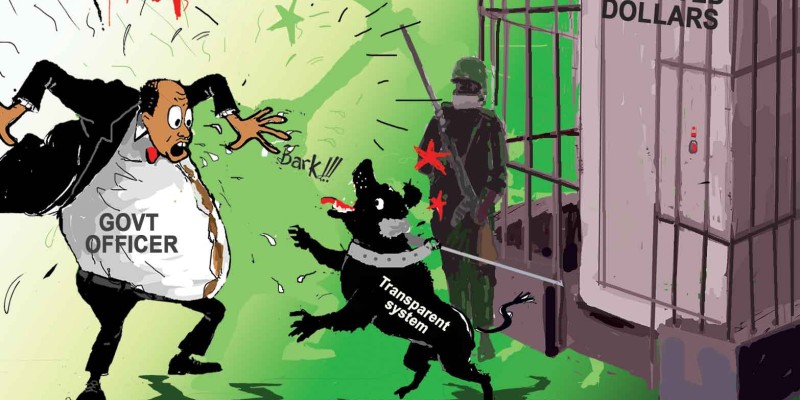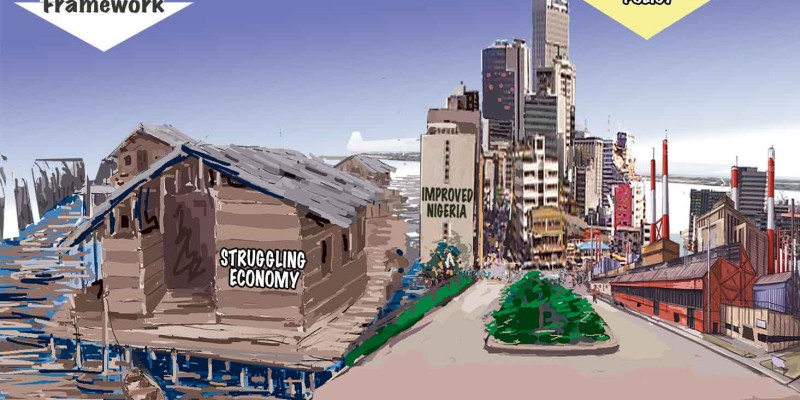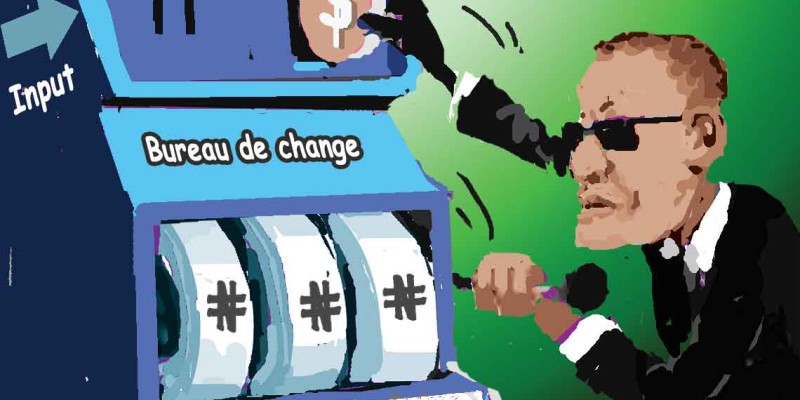Font size:
Print
The hopes for quickening Nigeria’s economy stuck in low growth failed to yield the desired results in 2018. The missing link in revving up the economy is rooted largely in insufficient doses of credit and capital injections. Weak financial intermediation is ranked one of the main downside risks to the nation’s economic outlook.
Monetary policy has remained stringent with a cash reserve requirement that sterilizes 22.5 percent of bank liquidity. High interest rate policy, retained so far, has induced borrowers to make deleveraging their balance sheets a major focus since 2018. Effectively, money has flowed farther off productive functions and even the weak growth in the economy has been a jobless growth.
Banks and businesses have been moving in the direction of cutting down lending and borrowing respectively in the light of heightened operational risks. For banks, rising credit losses is a major discouragement to keep lending. Loan impairment expenses aggregating about N2 trillion in the past five years, stand as a monument of discouragement to banks in the lending field. The oil & gas sector, where much of the bad loans reside, has continued to record drops in output and contribution to GDP.
Lending and borrowing apathy
On the part of companies, inability to sell in markets strapped of cash, is hurting sales revenue badly. Cost cutting has therefore become the only means of defending profit and high interest expenses aren’t letting companies with substantial bank borrowings move in this direction.
High finance charges are squeezing profit margins, hindering profit growth and inducing losses in companies big and small and this has been the trend for some years now. In the worst cases, operating profits are insufficient to cover finance expenses. Freeing themselves from high cost credits has become a general strategy for rebuilding falling corporate profits or turning around from losses.
Companies are resorting to low cost financing options such as rights issues and interest free supplier credits while banks moved further into investment assets led by government securities in 2018. Government’s borrowing needs continue to expand in the face of revenue disappointments and it needs high domestic bond yields to attract foreign portfolio investors.
At the same time, high bond yields have provided a fertile ground for banks to moderate the elevated risk in lending, diversify the portfolio of earning assets and still earn decent incomes. A drop in lending to the private sector and increase in investing to finance government fiscal deficits are the summary of the developments in the financial markets in 2018. This reflects the vexed issue of crowding out the private sector in respect of which the monetary policy committee of the Central Bank of Nigeria [CBN] continued to sound serious warning notes.
Government’s domestic borrowing has climbed to the region of excessiveness and the bulk of its spending remains in recurrent items, of which debt servicing is a significantly growing part. The continual shift of money from productive to non-productive activity in the credit markets needed to change.
Getting money back into production
The CBN has moved to curb banks’ appetite for risk free, fixed income investments - that have occupied an enlarged share of bank balance sheets. The bank issued a new policy guideline in July 2019 requiring banks to maintain a minimum loan deposit ratio of 60 percent by the end of September. The policy is intended to strengthen financial intermediation amidst regulatory and operational hurdles that have hindered bank lending.
The new lending policy places on banks the responsibility of leading a correction in the flow of money and credit. The objective is to ensure that growing loans and advances to customers will henceforth be the major route to expanding the asset side of bank balance sheets.
With government spending largely recurrent and bank lending and borrowing subdued, the economy is stuck in low growth. A disappointing performance of the oil sector leaves the overall economic growth well below potential.
Economic recovery has remained weak and GDP growth insufficient to translate into new job deliveries and poverty reduction. Fiscal 2018 ended with a wide gap between the aggregate economic numbers and the living conditions of the average Nigerian family.
Fiscal gap with monetary squeeze
Fiscal gap keeps widening, painting a gloomy picture of impending fiscal crisis. Declining fiscal space continues to keep macroeconomic policy equation out of balance. The CBN says this is the main handicap in navigating the economy towards recovery. Widening fiscal gap with credit freeze presents an ominous combination for an economy hungry for recovery and growth.
The trends have fostered job losses on both sides of lenders and borrowers to the point of serious concern that unemployment could trigger another recession in 2019. With burgeoning youth population unmatched by job growth, declining per capita income and spreading poverty, unemployment seems set to rise above the historic high of 40 percent this year.
In order to deliver new jobs, the economic growth momentum needs to speed up. Stepping up growth requires a strong dose of fiscal injection alongside policies that will ease the pain of borrowers and reinforce the liquidity of banks. The CBN’s new lending policy is a best effort move within the fiscal and monetary constraints. It isn’t a capacity enhancement of banks in the credit market but rather a shift of existing earning assets in favour of loans and advances to customers.
Policymakers aren’t yet moving in the direction of stimulatory actions needed to stimulate the economy and encourage bank lending. This includes fiscal injections and a downward shift of the key monetary control levers of the CBN. The benchmark interest rate is still hanging at 13.5 percent and cash reserve requirement cuts off 22.5 percent of bank deposits from lending.
The apex bank wants inflation rate to drop to single digit from the current level of about 13 percent before lowering interest rates. Lenders and borrowers are in the same waiting game - for interest rate cut to encourage them to lend and to borrow.
Banks under pressure
At the moment, most banks are still carrying a lot of problem loans in the books. The economy is yet to break free from the difficulties that made good loans go sour. The new lending policy spikes off some concerns that it may be exposing bank capital and depositors’ funds to greater risk.
The new lending rule appears to rest on a presumption that borrowers are keen to borrow but banks are unwilling to lend. The facts on ground tend to contradict this position however. Companies, large and small, are dumping bank loans on account of high finance charges that have made them to work for lenders rather than for shareholders.
Banks themselves are circumscribed by the prolonged weak macroeconomic environment that has continued to impact negatively on the banking sector’s stability. The lending business is presently at the crossroads with rising interest expenses and huge credit losses squeezing net interest income. In the past five years, hardly has any bank been able to grow net interest income reasonably on account of rising cost of funds and mounting credit losses.
Sub-optimal growth has continued to hinder the core business of banks and interest income – their main earning line, continues to be constrained. High cost of funds is hurting both banks that administer it as well as businesses. Inability to grow interest income ahead of interest expenses has remained a major challenge to the banking industry.
Net interest income continues to decline or record weak growth industry wide as interest expenses are claiming increased proportions of interest income in many banks. The core business of lending and investing did not contribute to profit improvements recorded by banks in 2018. This highlights the fundamental problem of the industry that is often overshadowed by bottom line numbers.
Inability to improve revenue was a general banking industry problem in 2018, which has sustained so far into the 2019 financial year. This is pointing to the weakness in interest income. The few banks that were able to grow revenue in 2018 did so by growing transaction-based earnings. Revenue performance generally failed to provide the strength to grow profit in the year.
Profit improvements, where recorded, happened through cost cutting that has replaced revenue growth as an avenue to grow profit. The same pattern of cutting costs to defend profit in a non-revenue growing situation has marked the operations of banks generally at the end of half year operations in June 2019.
Cutting credit losses
The biggest cost saving by banks in 2018 came from loan impairment loss reductions. That was the singular factor that powered profit performance among banks in the year while revenue constraints remained. The bigger the cuts in credit losses, the stronger the profit performance a bank attained in the year.
Total loan impairment expenses for 11 listed banks dropped by 68 percent in 2018 from a historic peak of over N472 billion in 2017 to N150 billion. Some banks recorded significant net write backs of previous credit loss expenses, which enabled almost every bank to grow profit far ahead of revenue.
Against an average increase of 3 percent in gross earnings for the 11 listed banks last year [excluding Unity Bank’s extreme figures], they grew after tax profit by an average of 35 percent. The much cost savings from loan loss expenses last year have thinned down so far this year, indicating that a general slowdown in profit improvements by banks is to be expected in 2019.
The ability of banks to innovate and defend profit seems to have continued to obscure the underlying industry problem facing them in the core business. The problem transcends beyond the banking industry and now stands as a national problem. Banks aren’t building the nation’s productive capacity and this isn’t counted against them in unwillingness but against the operating environment for discouragement.
Patchy performance
Looking at bank profits as an indication that all is well with banks will be to ignore the unsupportive policy environment that has dislocated their core business, experts point out. High interest rates are constraining lending and borrowing and therefore stand in the way of employment growth, as interest expenses gulp revenues of companies and banks, erode profits or create losses, warranting continuing layoffs.
The earnings picture of banks continues to reflect a patchy performance since 2013. There has not been any revenue line that has provided sustained growth for any bank since then. The overall picture is one of a random walk: an outstanding income line in one year suddenly becomes a drag the following year.
Profit performance follows the same picture of sudden twists and turns from year to year. In 2017, exchange gains provided the strength for most banks to improve revenue and profit. In 2018, the strength to grow revenue was completely missing while major declines in loan loss expenses provided the saving grace to push profit.
The industry leading banks recorded the weakest revenue performances in 2018 with some of them posting the first revenue drops in many years. For some other banks that recorded stronger revenue growth in the year, it was still a slowdown from the preceding year’s growth numbers. Yet for others, it was a continuation of moderate or flat growth in a long decelerating trend.
Windfalls from write backs
When it comes to profit performance, the 2018 financial year was a year of revival for almost all the banks. Loan recoveries and write backs came like a windfall that enabled banks to grow profit well ahead of the unimpressive revenue growth records. Many banks ended the year with the strongest profit advances seen since 2012. The most successful banks on the loan recovery front posted net write backs of loan impairment expenses to profit.
The drop in credit loss expenses has halted a trend of rising proportions of bank revenues devoted to that expense line, lifting a big weight off profit margins. The average industry net profit margin rose to a six-year high at 15.9 percent in 2018, almost matching the industry’s 16 percent mark in 2012 – its best record in the post financial crisis trading.
Another favorable development in the year is rebuilding of customer deposits by almost all the banks after two to three years of losses. Loss of customer deposits had led to reductions in the size of balance sheets of many banks in 2015 and 2016. Fiscal 2018 was the first time banks recorded a general improvement in their principal liabilities since the withdrawal of public sector deposits in 2015.
Earnings Table: How they stand
Bank Gross Earnings Nm Net Profit Nm Net Interest Income Nm
2017 2018 % Growth 2017 2018 % Growth 2017 2018 % Growth
ACCESS 459,075
528,745
15.2 60,087
94,981
58.1 163,451
173,578
6.2
FBNH 595,446
583,477
-2.0 41,328
58,999
42.8 331,522
284,168
-14.3
FCMB 169,882
177,249
4.3 8,613
14,972
73.8 70,525
72,573
2.9
Fidelity Bank 180,244
188,873
4.8 17,768
22,926
29.0 68,141
69,587
2.1
GTB 419,226
434,991
3.8 167,046
183,852
10.1 246,663
222,433
-9.8
Stanbic IBTC 212,434
222,360
4.7 46,195
72,087
56.0 83,587
78,209
-6.4
Sterling Bank 133,490
152,164
14.0 8,020
9,218
14.9 50,174
55,281
10.2
UBA 460,761
494,464
7.3 75,004
75,359
0.5 207,632
205,646
-1.0
UBN 163,844
145,517
-11.2 12,288
17,648
43.6 66,669
55,350
-17.0
Unity Bank 89,925
37,325
-58.5 -14,918
1,269
108.5 51,176
13,970
-72.7
Wema Bank 65,268
71,529
9.6 2,255
3,326
47.5 19,767
26,992
36.6
Zenith Bank 745,189
620,344
-16.8 177,614
193,147
8.7 257,991
295,594
14.6
In terms of ability of banks to generate wealth for shareholders, 2018 was one of the best years so far. Asset turnover failed to improve due to revenue growth constraints but gains in profit margins countered the weakness and registered improved rates of return.
Dividend payment has improved in terms of regularity, dividend per share and the number of banks involved. A few banks are still carrying negative reserves and only one bank closed the year with negative equity capital.
Impairment Charges for Credit Losses Nm
BANK 2010 2011 2012 2013 2014 2015 2016 2017 2018
Access 4,708 9,445 10,022 -6,163.50 11,652.30 14,224.70 21,952.80 34,467 14,657
UBA 18,213 22,628 4,560 13,078 6,578 5,053 29,898 32,895 4,529
Zenith 4,353 24,303 9,099 11,067 13,064 15,673 32,350 98,227 18,372
GTB 8,318 19,145 739 2,886 7,098 12,408 65,290 12,169 4,906
FBNH 21,590 38,011 12,549 20,309 25,942 119,322 222,908 150,424 86,911
Stanbic-IBTC 620 4,705 6,895 2,667 3,217 14,913 19,803 25,577 -2,940
Sterling 2,591 6,034 -243 8,259 7,389 8,151 11,714 12,267 5,843
Fidelity 3,570 16,726 4,610 7,630 4,306 5,764 8,671 11,315 4,215
Union 17,972 94,059 1,549 12,066 4,828 9,948 16,582 25,609 -3,374
Unity 6,795 1,118 1,353 21,593 15,054 27,122 35,949 44,254 161
Diamond 22,862 55,409 17,028 23,297 26,371 55,172 59,024 ------- -------
Wema -20,278 2,294 4,953 -1,330 88 -78 -412 2,180 3,510
FCMB -439 32,453 12,698 7,983 10,640 15,033 35,552 22,667 14,113
Skye 7,921 26,591 -13,121 12,677 18,992 21,536 NA ------ ------
Total 98,796 352,921 72,691 136,018 155,220 324,243 441,234 472,051 150,903
Dealing with elevated risk
Nigeria is ranked high on default risk, which keeps rising due to liquidity challenges in the foreign exchange market. Bank borrowers are also affected adversely by continuing depreciation of the naira that raises costs, erodes profit margins and constrains cash flow. Much of bank’s bad debts are upstream oil and gas assets created at higher crude oil prices. Increased involvement in oil and gas lending has exposed banks to the high volatility of the oil market.
Foreign currency-denominated assets constitute a relatively high proportion of the total banking industry loan book at 37 percent. Depreciation of the naira therefore exposes this class of borrowers to huge foreign exchange losses. The assets consequently carry very high risk of default. Local currency depreciation enlarges the debt obligations of borrowers beyond their expectations.
The conditions affecting users of bank credit seem to be underplayed and an impression of unwillingness to pay is often presumed. This is seen as pushing to the rear the challenges that government and regulators need to deal with in order to reduce default risk and optimize the functioning of the credit markets.
Both banks and borrowers are eagerly waiting for the macroeconomic concerns in the country to be allayed. To economists, private sector operators generally are presently doing whatever they can to make the best out of the economic situation. In their view, the ball lies on the court of fiscal and monetary authorities to step up economic growth and maintain stability in the economy to empower economic activities, reduce loan default risk and restore confidence between bankers and their customers.
A policy question
Macro-economic instability, coupled with a high level of policy uncertainty, continues to place the banking industry on its toes. A lack luster approach to stimulatory fiscal injections amidst monetary policy tightening has kept the economy and its growth functions on the slow lane over the past four years. The policy environment is seen to have hindered both banks and borrowers from launching out into new capacity building ventures.
Foreign investors as well as domestic business operators speak of major investment decisions suspended because of policy uncertainty heightened by the 2019 election cycle. The investment community is again waiting on the government to define a clear policy direction.
Decisive actions are expected of government to build confidence through stimulatory policies in the post-election economy. Policies that will encourage borrowers and lenders to produce and to consume are considered quite imperative to drive growth with new jobs without further delay.
Net Profit Margin %
BANK 2010 2011 2012 2013 2014 2015 2016 2017 2018
Access 12.3 11.3 16 17.5 17.3 19.4 18.6 13.1 18.0
UBA 0.4 -5.7 24.8 17.4 16.2 18.6 18 16.3 15.2
Zenith 19.4 18 34.3 28.2 24.7 25 25.5 23.8 31.1
GTB 24.6 26.1 39.2 36.9 33.7 32.7 31.7 39.8 42.3
ETI 11.6 13.6 11.1 3.7 11.5 2.3 -9.5 7.2 10.5
FBNH 13.6 7.1 20.8 17.8 17.5 30.7 2.4 6.9 10.1
Stanbic-IBTC 15.5 9.6 9.7 16.7 24.3 11.07 15.8 21.7 32.4
Sterling 14.1 14.5 10.1 9 8.7 9.3 4.6 6.0 6.1
Fidelity 10.7 3.9 15.2 6.1 10.4 9.5 6.4 9.9 12.1
Union 85.9 -81.8 4.1 6.1 10.4 9.5 6.4 7.5 12.1
Unity 19.2 5.8 11.5 -36 13.8 6.1 2.6 -16.6 3.4
Diamond 1.4 -12.9 16.1 15.9 12.2 2.6 1.6 - -
Wema 78.3 -18.4 2.6 5.5 5.6 5.2 4.8 3.5 4.6
FCMB 12.7 -12.3 13.1 12.4 15 3.2 8.1 5.1 8.4
Skye 12.3 1.6 9.9 12.5 13.7 -24.9 NA - -
Industry Average 11.4+ 4.4* 16.1 11.31 15.7 10.7 9.8
11.1 15.9
*Excludes Union Bank’s extreme figure
+Excludes Union Bank and Wema Bank’s extreme figures
Access Bank
Summary of 2018 operations
Access Bank rebuilt profit in the 2018 financial year from a drop in the prior year and set a record of the highest profit advancement in six years. The bank closed the year with a strong final quarter that produced close to 30% of gross earnings and more than one-third of profit.
It was an impressive earnings story for the bank in 2018, pushing gross income by 15% up on a strong growth of 20% in the preceding year. The strong growth in revenue is one of the critical factors in the improved earnings story of the bank that saw a 58% profit leap in 2018.
Another key factor in the performance is a drop of over 57% in loan impairment expenses. With that, the bank changed direction from major increases in the preceding three years to the first drop in loan impairment expenses since 2014. A 55% drop in tax expenses provided the third leg of the bank’s high profit growth tripod in 2018.
Outlook for 2019
Access Bank unveiled its post-merger status with Diamond Bank in the first quarter of 2019. The bank has shown new strengths in critical areas, recharging further the enhanced operating momentum it gained in 2018. It has emerged a carrier of the largest earning assets in the Nigerian banking industry as well as the biggest revenue earner.
The established strength of Diamond Bank in retail business has come handy for Access Bank to ascend to the position of the largest single depository with customer deposits in the region of N4 trillion. This is a 53% jump from N2.56 trillion customer deposits at the end of 2018. The development has diluted cost of funds, improved margins and profit capacity.
The business combination has given birth to a N6.43 trillion naira bank, forming the largest banking institution in Nigeria by the size of the balance sheet. This is a high jump of 30% from the closing asset figure of under N5 billion in 2018.
The overnight swelling of the size of the balance sheet has extended further the bank’s pre-merger lead as the biggest lender. Access Bank was already carrying the largest credit portfolio in the banking industry at about N2 trillion before the merger. It has extended the leadership by loan portfolio with a net lending to customers position of N2.6 trillion at the end of the first quarter of 2019.
Expansion of earning assets has increased the earning capacity. Gross earnings grew by 15% year-on-year to N160 billion in the first quarter. Both interest and non-interest income contributed to the revenue improvement recorded over the period. The full year outlook indicates another strong growth in revenue for the bank in 2019.
The ability to convert revenue into profit has also improved. There is a big leap in net profit margin from 18% at the end of 2018 to almost 26% at the end of the first quarter. Access Bank hasn’t seen profit margin that high in many years.
First quarter ended with an after tax profit of N41 billion, a towering year-on-year growth of 86%. Cost moderation is one of the key strengths of the bank in the post-merger trading. The relatively high speed of growth in interest expenses experienced in the past two years has moderated and so has the proportionate claim of cost funds on revenue.
Compared to an increase of 15.8% in interest income to about N111 billion in the first quarter, interest expenses increased by less than 6% to N53 billion during the period. This enabled a 27% expansion in net interest income to about N57 billion, a positive indication amidst a generally decelerating net interest income in the banking industry.
Further strength in operations came from a drop of 32% in net impairment charge, which has sustained a major drop recorded in 2018. This indicates improving loan recoveries and write backs of previous charges to profit.
Cost saving in the area of operating expenses is yet another major strength the bank is putting up in the post-merger operations. Apparently with economy of scale benefits, total operating expenses increased just slightly in the first quarter, which reduced operating cost margin and improved profit margin for the bank.
Access Bank succeeded in rebuilding profit in 2018 from a drop in the prior year, ascending to a new profit high of N95 billion in the year. The 58% leap was one of the highest profit advances in the banking industry in the year. The bank looks set to maintain the top tier profit growth range this year.
The key operating functions that powered the profit lifting of last year are still in force, even recharged. The strength from revenue is still in place and a major drop in loan impairment expenses, is equally being maintained in the current year.
FBN Holdings
Summary of 2018 operations
FBN Holdings stayed the course of its turnaround strategy in 2018, attaining another great milestone in rebuilding profit. The year also marked a significant progress in loan recoveries and improvement in risk asset quality. The bank closed the 2018 financial year with a 58% leap in after tax profit to nearly N60 billion. This is a further advance on its turnaround performance in 2017 when group profit tripled to N38 billion.
Profit performance is improving as management is succeeding in trimming credit losses. Loan impairment expenses dropped for the second year by 43% in 2018 after a 33% drop in the preceding year. This reflects increasing write backs of previous loan impairment expenses to profit.
The good news from the bank’s 2018 operations is that management reclaimed spending on bad borrowers to build wealth for shareholders. There is also a fundamental redressing of the balance sheet to address credit quality challenges and rebuild earning capacity.
A major development in 2018 is the cutting down of the size of the credit portfolio by 16% to N1.7 trillion – the lowest net lending position of the bank since 2013. The effect of that is that loans and advances have shrunk from over 50% of total assets in 2014 to 30% at the end of 2018.
Management tried to treat the wounds of credit losses through a redressing of the balance sheet. It raised investment securities by 33% to about N1.7 trillion in 2018. Despite the sustained drop in loan impairment expenses, the figure remained quite large at N87 billion in 2018.
Outlook for 2019
A hike in operating cost upset the growth functions of FBN Holdings in the second quarter of 2019. The company ended half year operations with total operating cost claiming half of gross earnings - the highest cost margin any time since 2013.
The effect of the cost upsurge is the weakening of the ability to convert revenue into profit. Profit margin slipped from 11.4% in the same period last year to 10.8% at the end of half year operations in June 2019.
Against an increase of 7% in the first quarter, after tax profit went down by 5.4% to N31.72 billion at half year. The bank began the current financial year raising hopes to maintain its profit rebuilding course for the third year running. The cost and income relationship needed to make that happen faltered in the second quarter.
Good news however continues to come from loan impairment expenses – which have provided the force for profit recovery in the past two years. Loan impairment charges dropped by 58% at half year, accelerating from a drop of 45% in the first quarter. The cost saving boosted interest income net of loan impairment expenses by as much as over N30 billion.
Rising operating cost however prevented the cost saving from flowing down into the bottom line. Having overcome the challenge of massive loan losses that sent profit crashing for two years, the bank has been contending with rising operating cost since 2017.
FBN Holdings is currently facing a year in which its inability to raise gross earnings is likely to last for the third year. The ability to improve profit then depends on how much costs it can save. The upsurge in operating cost at the end of half year has undermined cost saving prospects significantly.
The company closed half year trading with gross earnings flat at N294.22 billion. The problem remains interest income – the main revenue line, which declined by 1.6% to about N222 billion at the end of June. Non-interest income leveled up the decline with an increase of 6.6% but could not drive an increase in gross earnings.
There was a change in the structure of earning assets at the end of June 2019, reversing a shift of substantial resources from loans and advances to investments that happened last year. Management is again rebuilding the customer loan portfolio after it dropped by 16% last year to the lowest mark in six years.
The bank closed half year operations with an after tax profit of N31.72 billion, a year-on-year decline of 5.4%. The momentum needed to keep profit growing for the third year on has weakened for FBN Holdings. Management needs to recharge revenue growth functions and/or squeeze operating cost to regain the momentum in the second half.
The high point of the company’s operating story at the end of June 2019 is a drop of 58 percent in loan impairment expenses to N22 billion. This indicates a sustaining gain in credit quality with the drop in loan impairment charges accelerating from 45 percent in the first quarter.
FCMB
Summary of 2018 operations
First City Monument Bank [FCMB] made a big turnaround in the 2018 financial year, raising profit a clear 74% to a four-year peak at roughly N15 billion. It was a rebound from a 34% profit drop in the preceding year.
Revenue was only moderately improved at 4% in the year but quite better than a decline of close to 4% in the preceding year. Interest income was marginally down and an increase of 22% in transactions income accounted exclusively for the improvement in gross earnings in the year.
The high points of the bank’s upturn in 2018 are an upsurge of 158% in net trading income, a 29% growth in fees/commissions and a drop of 38% in net loan loss expenses. Also, interest expenses changed direction from growing well ahead of interest income in 2017 and declined well ahead of it in 2018.
The rein on interest expenses reflects an outstanding growth in low cost customer deposits in the year at 19%. With reduced average cost per naira of deposits, management was able to manage the constraint in interest income. That permitted a marginal increase in net interest income at the end of the year.
Reinforcing the favourable behaviour of interest expenses, net impairment loss on financial assets dropped for the second year in 2018. At a little over N14 billion, net credit loss expenses dropped for the second year by about 38% to register the lowest loan loss expense for the bank in four years.
Part of the revenue saved in interest expenses and credit loss expenses was claimed by operating cost, which grew by 14% to over N79 billion – the highest growth rate in four years. Despite that, the bank still achieved a 77% leap in operating profit to N18.44 billion at the end of 2018.
Outlook for 2019
FCMB is looking confident to raise gross earnings for the second year in 2019 and the best revenue growth record in three years seems to be in the making. A new strength in revenue growth was seen in the second quarter ended June 2019. That has stepped up gross earnings from a 4 percent improvement in the first quarter to a year-on-year increase of 7 percent at half year. The improved growth rate looks likely to follow the bank to full year.
The bank closed half year operations for 2019 with a little gain in momentum that has improved full year profit growth expectation from flat to moderate. The bank had raised net profit by 74% last year, from which a sharp slowdown is forecast for the current financial year. The bank’s profit growth records have shown a pattern of random up and down turns in recent years.
Rising interest expenses is a challenge in the current financial year. There is a change of direction from a decline in cost of funds last year to interest expenses growing ahead of interest income.
A major drop in loan impairment losses on risk assets last year was the big cost saving centre that spurred the big profit lifting in 2018. Loan loss expenses continue to decline so far in the current year but the cost saving isn’t going to be as much as was realised in the preceding years.
Half year operations ended with gross earnings of close to N90 billion for FCMB, an increase of 7 percent year-on-year. Interest and discount income is leading revenue improvement with an increase of 9.4% to N70.4 billion. Based on the accelerated growth rate in the second quarter, gross earnings outlook for the full year has improved.
Interest expenses are showing a slight moderation relative to interest income and that is strengthening net interest earnings. Net interest income has doubled up its growth rate from a marginal increase of 2.9% at the end of 2018 to almost 10% to N38.7 billion at the end of half year operations in June 2019.
Net interest income, has remained either flat or moderately improved since 2017. It is however likely to grow at the highest rate in five years in 2019.
Net impairment loss on financial assets dropped by 25 percent to N5.5 billion at the end of June 2019. This is a continuing decline for the third year running, having dropped by 38% in 2018 and 36% in 2017. The lowest loan loss expense for the bank in many years is expected at the end of 2019.
FCMB ended the first half with an after tax profit of N7.53 billion, an increase of 31% year-on-year. The profit outlook for the full year indicates that profit growth will slow down considerably from the half year growth record. Management continues to keep a tight control over operating cost, which has improved net profit margin from 6.8% in the same period last year to 8.4% at the end of June 2019.
Fidelity Bank
Summary of 2018 operations
Fidelity Bank lifted profit in 2018 a clear 29% up on the 225% advance in 2017. This is in defiance of a slowdown in revenue growth in the year. Gross earnings slowed down due to slacken performance of interest earnings. The bank’s management took steps to balance the cost and revenue developments and successfully extracted an increased profit per naira of earnings.
The bank’s performance in 2018 registered a positive impression of stability on the earnings track after a big turnaround in 2017. The ability to keep earnings on stable growth amid industry wide volatile behaviour of key income lines is a major accomplishment by the bank’s management in 2018.
The bank closed the 2018 financial year with gross earnings of N189 billion, an increase of 5% and a slowdown from 18.4% revenue growth in 2017. Interest income improved by 4% to N153 billion – a sharp slowdown from close to 20% growth in the prior year. An increase of 7% in non-interest income stretched out overall revenue growth to 5%.
Management applied a firm hold on costs to address the revenue slowdown in the year. This provided the room for improving profit margin and lifting profit close to six times as fast as revenue.
The biggest cost saving came from credit loss expenses, which dropped by 63% to N4.2 billion during the year. This enabled the bank to raise net interest income after credit loss expense by 15% to over N65 billion at the end of the year. The development is a positive indication for the bank in terms of visible progress in loan recovery and a generally improving risk asset quality.
Outlook for 2019
The weakness on revenue performance remains a challenge for Fidelity Bank in the current year, as interest income – the main revenue line of the bank is still constrained. However management is again carving its way to grow profit out of the tight revenue situation.
The bank’s first quarter report for the period ended March 2019 – the latest at press time, shows a strong growth in profit amid operating challenges. Credit loss expenses, which provided a big cost saving centre last year, are on the rise this year. Also, interest expenses are maintaining a trend of growing ahead of interest earnings for the third consecutive year.
The operating tide will need to change for the bank if it is to avoid a sharp slowdown in profit performance this year. Rising loan loss expenses by over 47% in the first quarter poses a big risk to the bank’s profit outlook for 2019.
Fidelity Bank ended first quarter trading in March with gross earnings of N48.44


